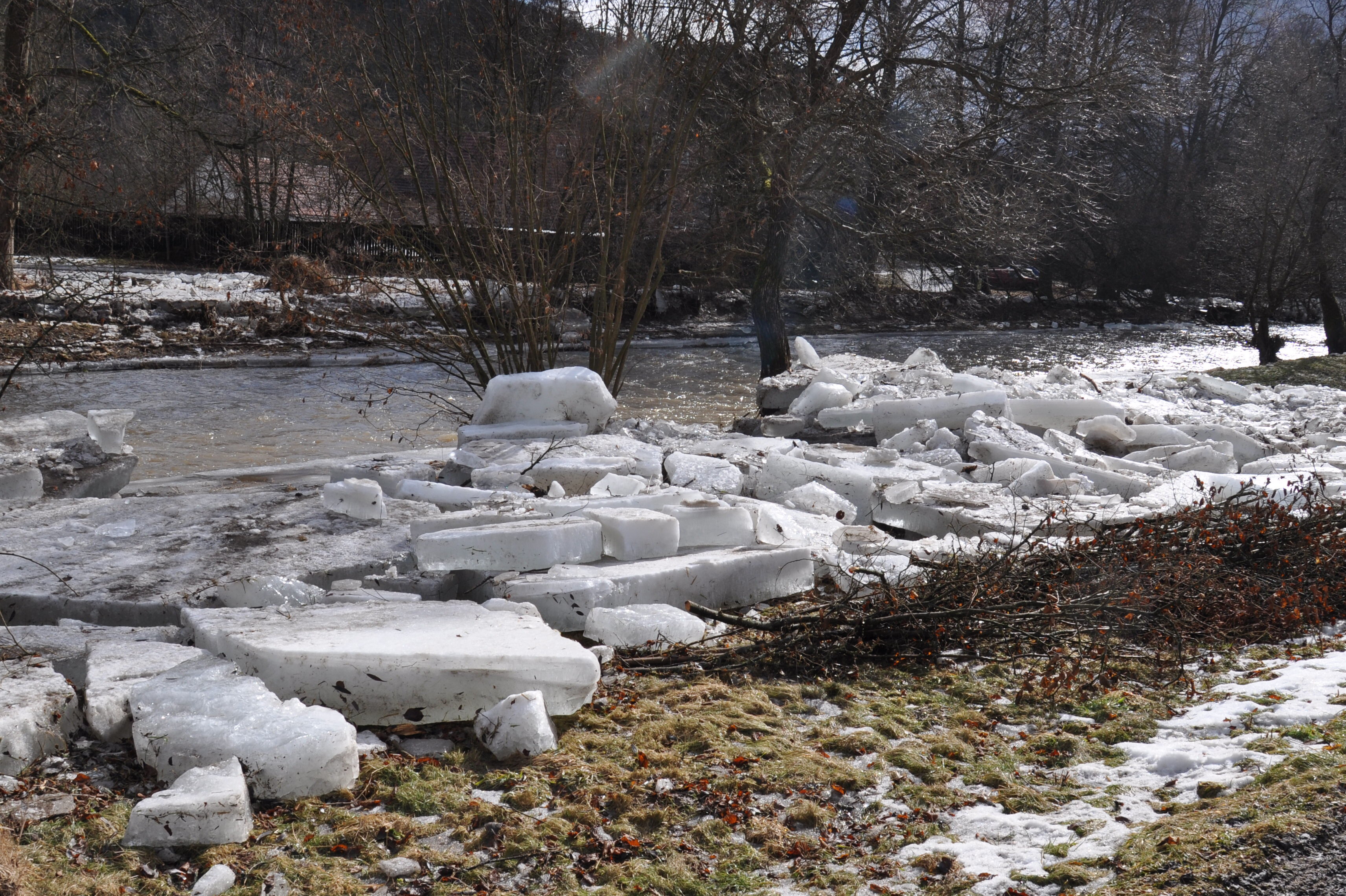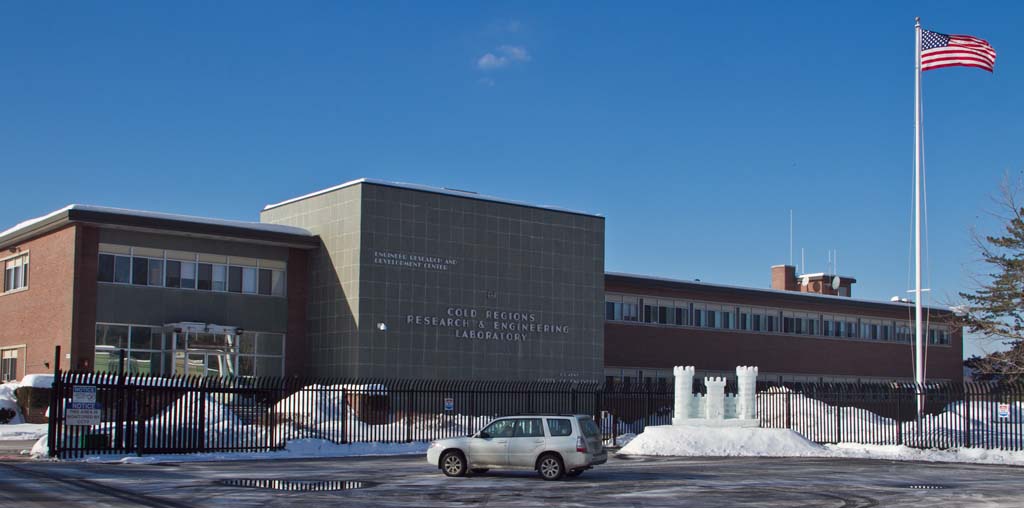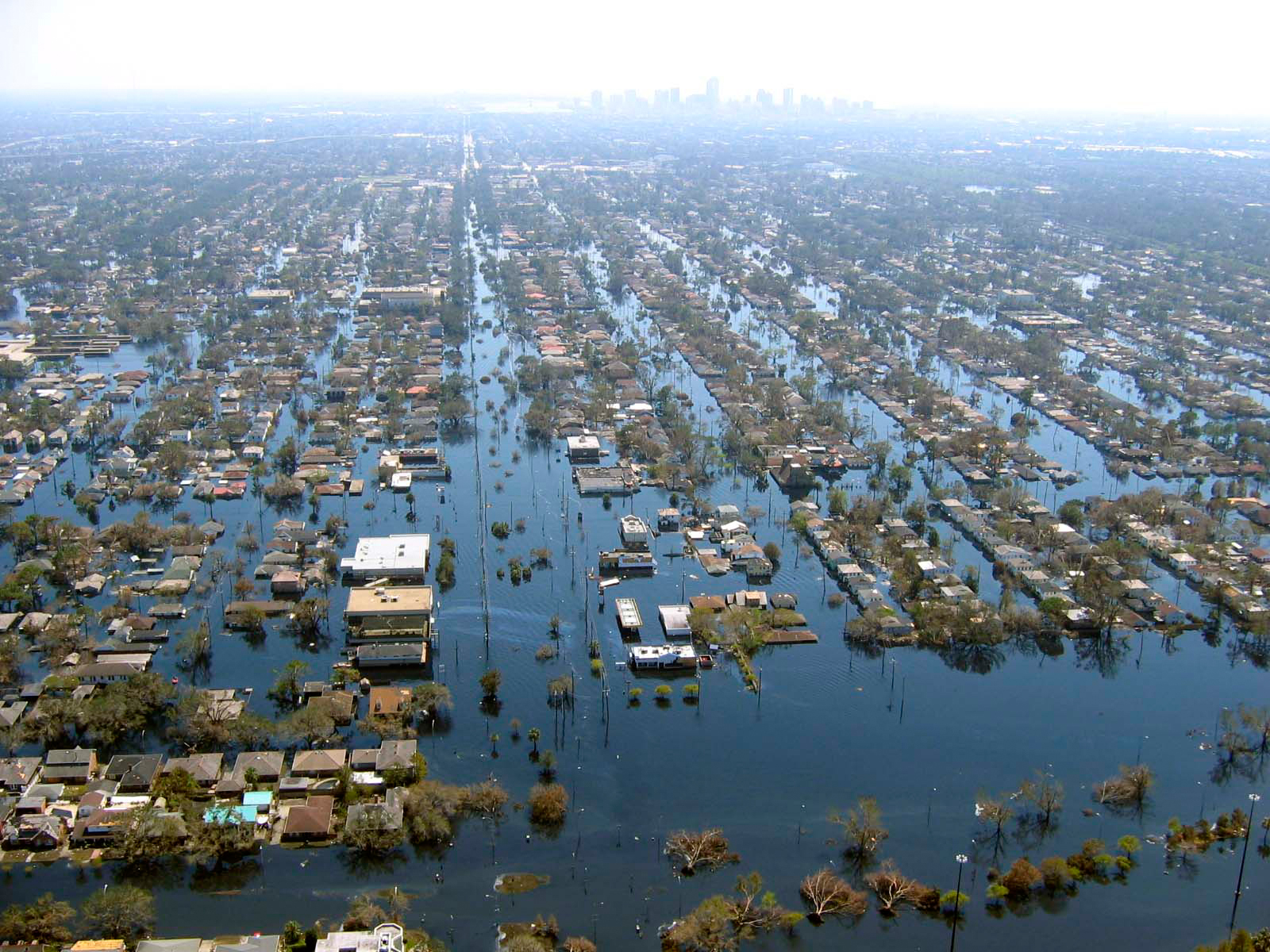|
Ice Jam
Ice jams occur when the ice that is drifting down-current in a river comes to a stop, for instance, at a river bend, when it contacts the river bed in a shallow area, or against bridge piers. Doing so increases the resistance to flow, thereby inducing an increase in water level upstream of the jam (referred to as ''backwater''). Ice jams are thus a main cause for flooding during the winter. In addition, when the jam is released, depending on the conditions under which this happens, the amount of water that was retained behind the jam can also lead to flooding ''downstream'' of where the jam occurred. Ice jam floods are generally less predictable and can also be faster than open-water floods. Snow or ice weather phenomena Mechanisms Ice jams on rivers usually occur in the springtime as the river ice begins to ''break up'', but may also occur in early winter during ''freeze-up''. The break-up process is described in three phases: pre-break-up, break-up and final drive. ''Pre-bre ... [...More Info...] [...Related Items...] OR: [Wikipedia] [Google] [Baidu] |
CRREL Ice Engineering Facility Model Of Cazenovia Creek Ice Jam Control Structure
The Cold Regions Research and Engineering Laboratory (CRREL) is a United States Army Corps of Engineers, Engineer Research and Development Center research facility headquartered in Hanover, New Hampshire, Hanover, New Hampshire, that provides scientific and engineering support to the U.S. government and its military with a core emphasis on cold environments. CRREL also provides technical support to non-government customers. CRREL arose from a consolidation of three antecedent organizations whose purpose was to understand frozen ground, permafrost, snow and ice as factors which were important in strategic northern areas during the Cold War. In its first 25 years CRREL researchers contributed to the understanding of polar ice caps, permafrost, and the engineering technology for developing natural resources in cold climates, such as Alaska. More recently, CRREL researchers have made contributions to science in climate change, the understanding of wave propagation for sensor systems, ... [...More Info...] [...Related Items...] OR: [Wikipedia] [Google] [Baidu] |
Flood
A flood is an overflow of water (list of non-water floods, or rarely other fluids) that submerges land that is usually dry. In the sense of "flowing water", the word may also be applied to the inflow of the tide. Floods are of significant concern in agriculture, civil engineering and public health. Environmental issues, Human changes to the environment often increase the intensity and frequency of flooding. Examples for human changes are land use changes such as deforestation and Wetland conservation, removal of wetlands, changes in waterway course or flood controls such as with levees. Global environmental issues also influence causes of floods, namely climate change which causes an Effects of climate change on the water cycle, intensification of the water cycle and sea level rise. For example, climate change makes Extreme weather, extreme weather events more frequent and stronger. This leads to more intense floods and increased flood risk. Natural types of floods include riv ... [...More Info...] [...Related Items...] OR: [Wikipedia] [Google] [Baidu] |
Weather Hazards
Severe weather is any dangerous meteorological phenomenon with the potential to cause damage, serious social disruption, or loss of human life. These vary depending on the latitude, altitude, topography, and atmospheric conditions. High winds, hail, excessive precipitation, and wildfires are forms and effects, as are thunderstorms, downbursts, tornadoes, waterspouts, tropical cyclones, and extratropical cyclones. Regional and seasonal phenomena include blizzards, snowstorms, ice storms, and duststorms. Severe weather is one type of extreme weather, which includes unexpected, unusual, severe, or unseasonal weather and is by definition rare for that location or time of the year.IPCC, 2024Annex II: Glossary öller, V., R. van Diemen, J.B.R. Matthews, C. Méndez, S. Semenov, J.S. Fuglestvedt, A. Reisinger (eds.) InClimate Change 2022: Impacts, Adaptation and Vulnerability. Contribution of Working Group II to the Sixth Assessment Report of the Intergovernmental Panel on Clima ... [...More Info...] [...Related Items...] OR: [Wikipedia] [Google] [Baidu] |
Flood
A flood is an overflow of water (list of non-water floods, or rarely other fluids) that submerges land that is usually dry. In the sense of "flowing water", the word may also be applied to the inflow of the tide. Floods are of significant concern in agriculture, civil engineering and public health. Environmental issues, Human changes to the environment often increase the intensity and frequency of flooding. Examples for human changes are land use changes such as deforestation and Wetland conservation, removal of wetlands, changes in waterway course or flood controls such as with levees. Global environmental issues also influence causes of floods, namely climate change which causes an Effects of climate change on the water cycle, intensification of the water cycle and sea level rise. For example, climate change makes Extreme weather, extreme weather events more frequent and stronger. This leads to more intense floods and increased flood risk. Natural types of floods include riv ... [...More Info...] [...Related Items...] OR: [Wikipedia] [Google] [Baidu] |
Glaciology
Glaciology (; ) is the scientific study of glaciers, or, more generally, ice and natural phenomena that involve ice. Glaciology is an interdisciplinary Earth science that integrates geophysics, geology, physical geography, geomorphology, climatology, meteorology, hydrology, biology, and ecology. The impact of glaciers on people includes the fields of human geography and anthropology. The discoveries of water ice on the Moon, Mars, Europa (moon), Europa and Pluto add an extraterrestrial component to the field, which is referred to as "astroglaciology". Overview A glacier is a persistent body of dense ice, a form of rock) formed from snow falling and accumulating over a long period of time; glaciers move very slowly, either descending from high mountains, as in valley glaciers, or moving outward from centers of accumulation, as in continental glaciers. Areas of study within glaciology include glacial history and the reconstruction of past glaciation. A glaciologist is a person ... [...More Info...] [...Related Items...] OR: [Wikipedia] [Google] [Baidu] |
Bodies Of Ice
Bodies may refer to: Literature * ''Bodies'' (comics), a 2014–2015 Vertigo Comics detective fiction series * ''Bodies'' (novel), a 2002 novel by Jed Mercurio * ''Bodies'', a 1977 play by James Saunders * ''Bodies'', a 2009 book by Susie Orbach Music Albums * ''Bodies'' (album), by AFI, 2021 * ''Bodies'' (album), by Thornhill, 2025 * ''Bodies'' (EP), by Celia Pavey, or the title song, 2014 Songs * "Bodies" (Sex Pistols song), 1977 * "Bodies", by Danzig from Danzig III: How the Gods Kill, 1992 * "Bodies", by the Smashing Pumpkins from '' Mellon Collie and the Infinite Sadness'', 1995 * "Bodies" (Drowning Pool song), 2001 * "Bodies" (Little Birdy song), 2007 * "Bodies" (Robbie Williams song), 2009 * "Bodies", by Megadeth from '' Endgame'', 2009 * "Bodies", by CeeLo Green from '' The Lady Killer'', 2010 * "Bodies", by Dominic Fike from ''Sunburn'', 2023 * "Bodies" (unreleased), by Kendrick Lamar from '' GNX'' trailer Television * ''Bodies'' (2004 TV series), a British ... [...More Info...] [...Related Items...] OR: [Wikipedia] [Google] [Baidu] |
Pressure Ridge (ice)
A pressure ridge, when consisting of ice in an oceanic or coastal environment, is a linear pile-up of sea ice fragments formed in pack ice by accumulation in the convergence between floes. Such a pressure ridge develops in an ice cover as a result of a stress regime established within the plane of the ice. Within sea ice expanses, pressure ridges originate from the interaction between floes,A ''floe'' is any individual piece of sea ice larger than . as they collide with each other.Weeks, W. F. (2010) ''On sea ice''. University of Alaska Press, Fairbanks, 664 p. Currents and winds are the main driving forces, but the latter is particularly effective when they have a predominant direction. Pressure ridges are made up of angular ice blocks of various sizes that pile up on the floes. The part of the ridge that is above the water surface is known as the ''sail''; that below it as the ''keel''.These terms also apply to any floating ice feature, such as icebergs. Pressure ridges are the ... [...More Info...] [...Related Items...] OR: [Wikipedia] [Google] [Baidu] |
Jamming (physics)
Jamming is the physical process by which the viscosity of some Mesoscopic physics, mesoscopic materials, such as granular materials, glasses, foams, polymers, emulsions, and other complex fluids, increases with increasing particle density. The jamming transition has been proposed as a new type of phase transition, with similarities to a glass transition but very different from the formation of crystalline solids. While a glass transition occurs when the liquid state is cooled, the jamming transition happens when the density, or the packing fraction of the particles, is increased. This crowding of the constituent particles prevents them from flowing under an applied stress and from exploring phase space, thus making the aggregate material behave as a solid. The system may be able to unjam if Packing density, volume fraction is decreased, or external stresses are applied such that they exceed the yield stress. This transition is interesting because it is Nonlinear system, nonlinea ... [...More Info...] [...Related Items...] OR: [Wikipedia] [Google] [Baidu] |
Ice Shove
An ice shove (also known as fast ice, an ice surge, ice push, ice heave, shoreline ice pileup, ice piling, ice thrust, ice tsunami, ice ride-up, or ''ivu'' in Iñupiat) is a surge of ice from an ocean or large lake onto the shore. Ice shoves are caused by ocean currents, strong winds, or temperature differences pushing ice onto the shore, creating piles up to 12 metres (40 feet) high. Ice shoves can be caused by temperature fluctuations, wind action, or changing water levels and can cause devastation to coastal Arctic communities. Cyclical climate change will also play a role in the formation and frequency of ice shove events; a rise in global temperatures leads to more open water to facilitate ice movement. Low pressure systems will destabilize ice sheets and send them shoreward. Also referred to as "landfast ice", it is an essential component to the coastal sea ice system, including the sediment dynamics. Arctic peoples utilize these ice shoves to travel and hunt. Ringed seals ... [...More Info...] [...Related Items...] OR: [Wikipedia] [Google] [Baidu] |
Fast Ice
Fast ice (also called ''land-fast ice'', ''landfast ice'', and ''shore-fast ice'') is sea ice or lake ice that is "fastened" to the coastline, to the sea floor along shoals, or to grounded icebergs.Leppäranta, M. 2011. The Drift of Sea Ice. Berlin: Springer-Verlag. Fast ice may either grow in place from the sea water or by freezing pieces of drifting ice to the shore or other anchor sites.Kovacs, A.and M. Mellor. 1974. "Sea ice morphology and ice as a geologic agent in the Southern Beaufort Sea." pp. 113-164, in: ''The Coast and Shelf of the Beaufort Sea'', J.C. Reed and J.E. Sater (Eds.), Arlington, Va.: U.S.A. Unlike drift (or pack) ice, fast ice does not move with currents and winds. The width (and the presence) of this ice zone is usually seasonal and depends on ice thickness, topography of the sea floor and islands. It ranges from a few meters to several hundred kilometers. Seaward expansion is a function of a number of factors, notably water depth, shoreline prote ... [...More Info...] [...Related Items...] OR: [Wikipedia] [Google] [Baidu] |
Drift Ice
Drift or Drifts may refer to: Geography * Drift or ford (crossing) of a river * Drift (navigation), difference between heading and course of a vessel * Drift, Kentucky, unincorporated community in the United States * In Cornwall, England: ** Drift, Cornwall, village ** Drift Reservoir, associated with the village Science, technology, and physics * Directional Recoil Identification from Tracks, a dark-matter experiment * Drift (video gaming), a typical game-controller malfunction * Drift pin, metalworking tool for localizing hammer blows and for aligning holes * Drift (geology), deposited material of glacial origin * drift (in mining), a roughly horizontal passage; an adit * Drift, linear term of a stochastic process * Drift (motorsport), the controlled sliding of a vehicle through a sharp turn, either via over-steering with sudden sharp braking, or counter-steering with a sudden "clutch kick" acceleration * Incremental changes: ** Drift (linguistics), a type of language ... [...More Info...] [...Related Items...] OR: [Wikipedia] [Google] [Baidu] |





